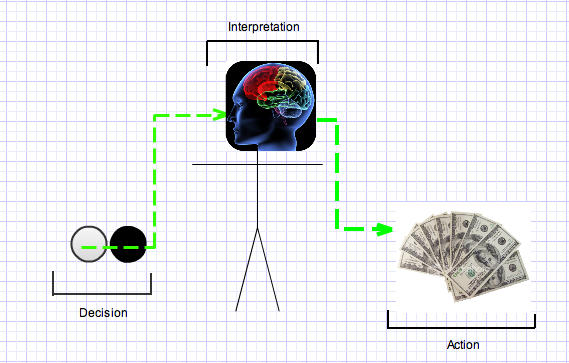Behavioral Economics – a first thought
May 2, 2010 2 Comments
So earlier this year, my friend Jason Bade (http://jasonbade.blogspot.com/) and Jen (official name: Jen Ying Zhen Ang) started a group on campus called the Behavioral Economists at Stanford. After much debate, we decided that the acronym for the group name should be BEAST after consulting with Chip Heath (author of Made to Stick and Switch). We like that BEAST is a name that is ‘sticky’ in the sense that you’ll remember it.
But anyways, the group was started out of the lack of opportunities at Stanford to learn about this up and coming field of Behavioral Economics and so we seek to use it to teach ourselves.
After much talking, thinking and reading about Behavioral Economics, I’ve come up with the following oversimplified model to explain it to most people:
In regular economics we see the following: A man is faced with a decision to make, the man then makes the rational and objective decision.
However, behavioral economics says that there is one step missing. And that is, the man sees a decision, interprets it, and then makes a rational decision based on their interpretation. Now as one of my friends pointed out, this isn’t quite a groundbreaking model. But it has so many implications! Should consumption today be worth less to you than consumption tomorrow? If you are super-rational, then I don’t think so, a carrot today should be the same as a carrot tomorrow because on both days, you are having the same good and you should enjoy it as much when you consume it in both time periods. Yet we discount consumption tomorrow. We don’t care about the carrot tomorrow as much as we care about the carrot today because your future-self will figure out how to maximize your satisfaction from consumption in the future.
Edit: For further discussion on discounting check out the comments section, my analysis here is not correct.
Here is a very common example that really gives life to this model (note, for this example it helps to know that empirically we’ve found that most people are risk-averse, which means that they prefer to avoid risky options for more secure options):
The Asian disease
Imagine that the United States is preparing for the outbreak of an unusual Asian disease, which is expected to kill 600 people. Two alternative programs to combat the disease have been proposed. Assume that the exact scientific estimates of the consequences of the programs are as follows: If Program A is adopted, 200 people will be saved If Program B is adopted, there is a one-third probability that 600 people will be saved and a two-thirds probability that no people will be saved
What option do you choose? Most people that were asked this question chose Program A. The expected value of both options is the same, but people prefer the less risky option as we are most risk-averse. This makes perfect sense right, by both the rational economics model and the behavioral economics model you should pick Program A. But now lets frame your options in a different way:
If Program A is adopted, 400 people will die
If Program B is adopted, there is a one-third probability that nobody will die and a two-thirds probability that 600 people will die
What do you pick now? Most people in this case pick Program B. Why? The problem is exactly the same, just the options have been framed differently. If the expected values are the same and you are risk averse, why would you pick the riskier option? This doesn’t make sense by the first model, but it does by the second model. Its because humans tend to prefer avoiding death twice as much as they prefer saving lives. We are willing to gamble when it comes to avoiding deaths, but not when it comes to saving lives.
The early thought leaders in the fields, Amos Tversky and Daniel Kahneman said “choices involving gains are often risk averse and choices involving losses are risk taking”. Think about it, in the first option you feel as though you’ve already saved 200 lives and so its worth more to you than option B which has the same expected value because its risky. But when it comes to losses, with the first option you feel that you’ve already made the loss, so gambling seems more attractive because the relief you would feel if you get rid of your losses is a lot greater than the extra losses you might make – sorta why we like to play ‘double-or-nothing’.
Though this is a very premature and oversimplified model. I’ll keep adding to it and evaluating more behavioral economics on this blog.
